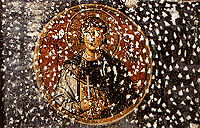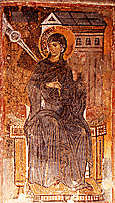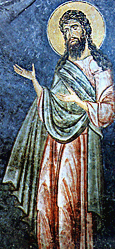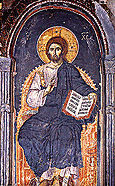 |
|
 |
Thessalonike - Mount Athos - Serbia
 hessalonike was an important
hessalonike was an important
 centre of the Byzantine Empire and the inheritor of a great artistic tradition. Indicative of its importance is the fact that, according to written sources, it was from the workshops of Thessalonike that the Serbian prince and archbishop,
Sava,
commissioned the icons he dedicated to Mount Athos. The Serbian kingdom, on the other hand, had become a new centre in which the arts flourished. The most important monuments of this period are to be found here and seem to be influenced by the art of Thessalonike. centre of the Byzantine Empire and the inheritor of a great artistic tradition. Indicative of its importance is the fact that, according to written sources, it was from the workshops of Thessalonike that the Serbian prince and archbishop,
Sava,
commissioned the icons he dedicated to Mount Athos. The Serbian kingdom, on the other hand, had become a new centre in which the arts flourished. The most important monuments of this period are to be found here and seem to be influenced by the art of Thessalonike.
 Some of the first works in which are evident the progressive tendencies of painting are the representations of Saints in the south
aisle of
the church of the Acheiropoietos in Thessalonike. The frescoes are characterised by a monumentality of style and an intensity of expression, features also Some of the first works in which are evident the progressive tendencies of painting are the representations of Saints in the south
aisle of
the church of the Acheiropoietos in Thessalonike. The frescoes are characterised by a monumentality of style and an intensity of expression, features also
 found later in Serbian monuments, such as the monastery of Mileseva, the church of the Holy Apostles at Pec, and most notably, the church of the Holy Trinity at Sopocani, a monument that breathes a new creative spirit into art. The role of Thessalonike as an artistic centre where new tendencies and currents take shape, where important artists work, and the influence of which radiates over the wider area, becomes clearly manifest at the end of the century. The painters Eutychios and Michael Astrapas of Thessalonike create the wall paintings of St Kliment (former Virgin Peribleptos) in Ohrid and are later engaged by the found later in Serbian monuments, such as the monastery of Mileseva, the church of the Holy Apostles at Pec, and most notably, the church of the Holy Trinity at Sopocani, a monument that breathes a new creative spirit into art. The role of Thessalonike as an artistic centre where new tendencies and currents take shape, where important artists work, and the influence of which radiates over the wider area, becomes clearly manifest at the end of the century. The painters Eutychios and Michael Astrapas of Thessalonike create the wall paintings of St Kliment (former Virgin Peribleptos) in Ohrid and are later engaged by the
 Serbian
kralj
Milutin, for whom they produce important works. According to Athonite legend, the famous artist Manuel Panselinos, creator of the frescoes in the Protaton, also came from Thessalonike. This important mural ensemble is the first major work produced during the period of intense artistic activity observed on Mount Athos towards the end of the century. This activity was not unrelated to the accession to the throne of
Andronikos II Palaiologos, who was
a
fervent supporter of monastic circles and especially of the monasteries of the Holy Mountain. It was to continue during the first decades of the 14th century, generating important works such as the wall paintings of the Vatopedi (1312) and Hilandar (1320) monasteries. Serbian
kralj
Milutin, for whom they produce important works. According to Athonite legend, the famous artist Manuel Panselinos, creator of the frescoes in the Protaton, also came from Thessalonike. This important mural ensemble is the first major work produced during the period of intense artistic activity observed on Mount Athos towards the end of the century. This activity was not unrelated to the accession to the throne of
Andronikos II Palaiologos, who was
a
fervent supporter of monastic circles and especially of the monasteries of the Holy Mountain. It was to continue during the first decades of the 14th century, generating important works such as the wall paintings of the Vatopedi (1312) and Hilandar (1320) monasteries.
|